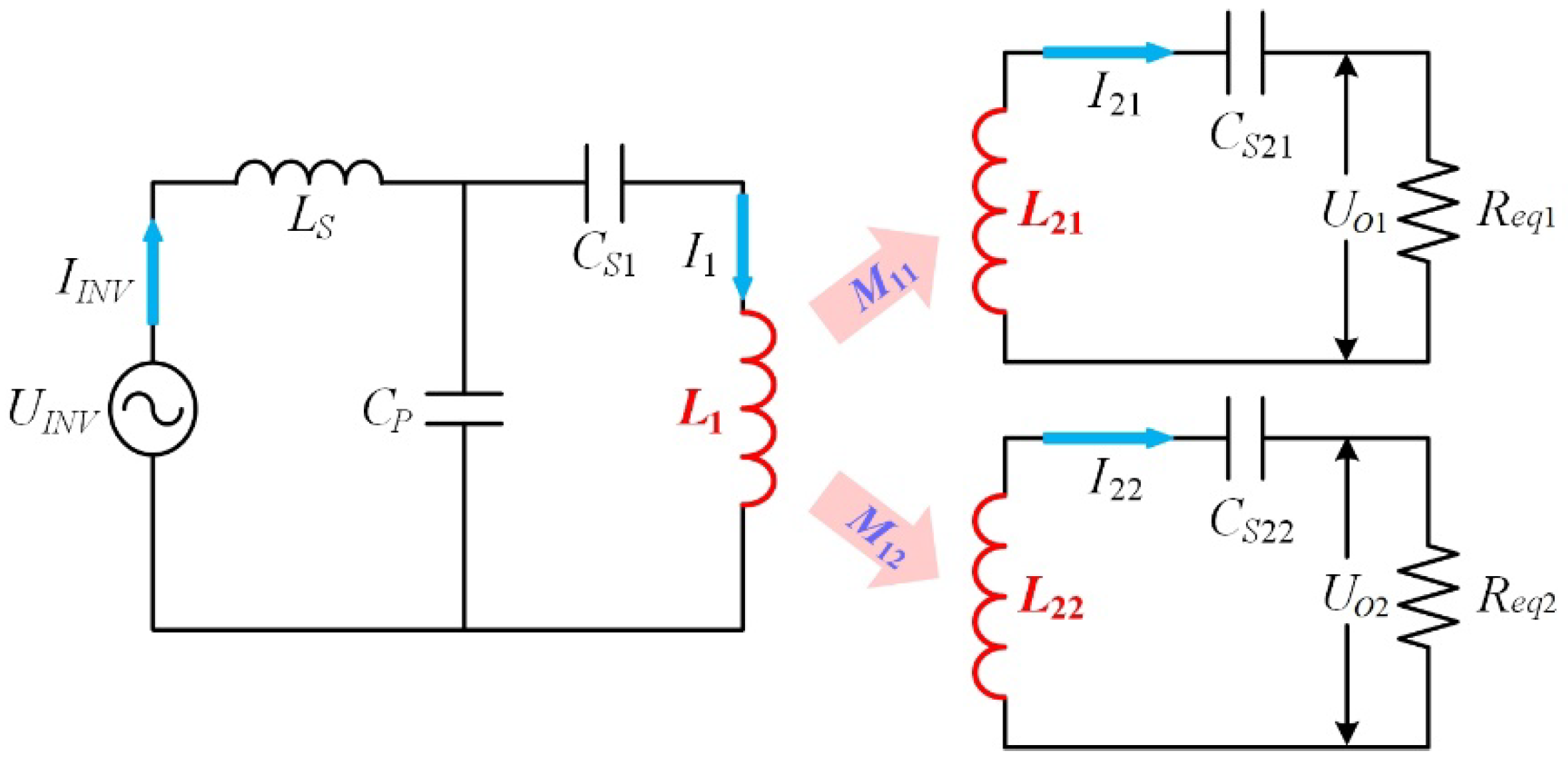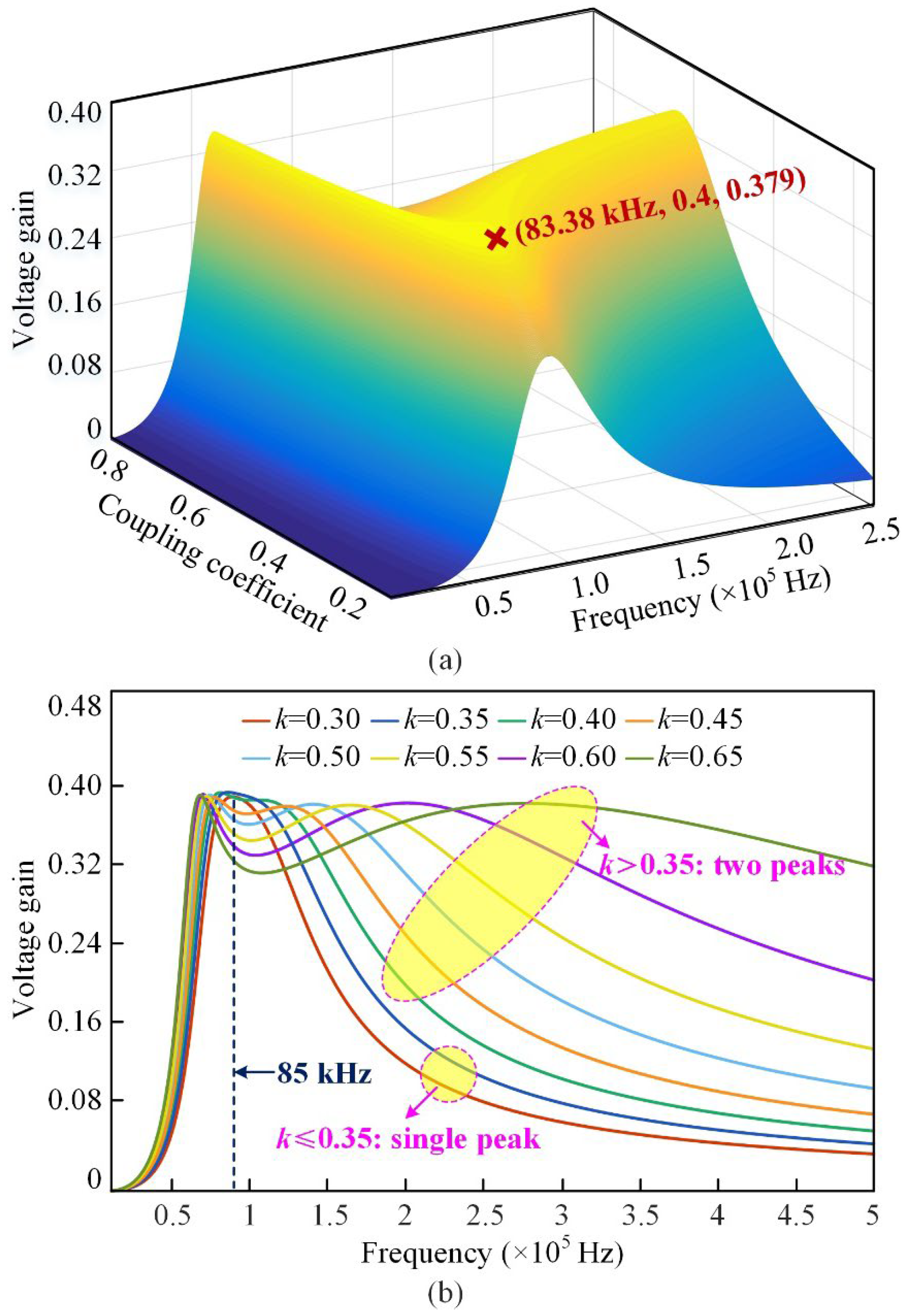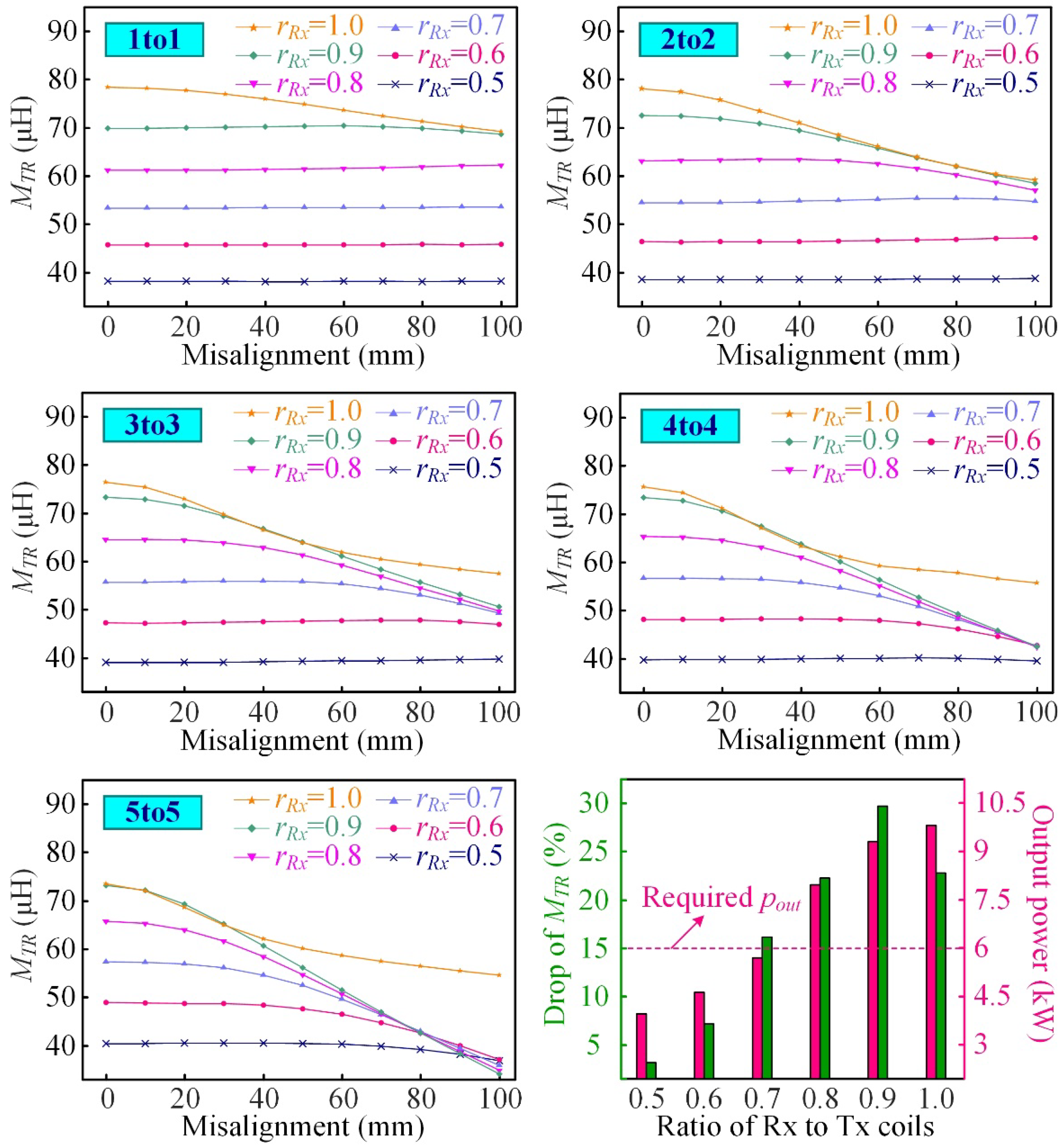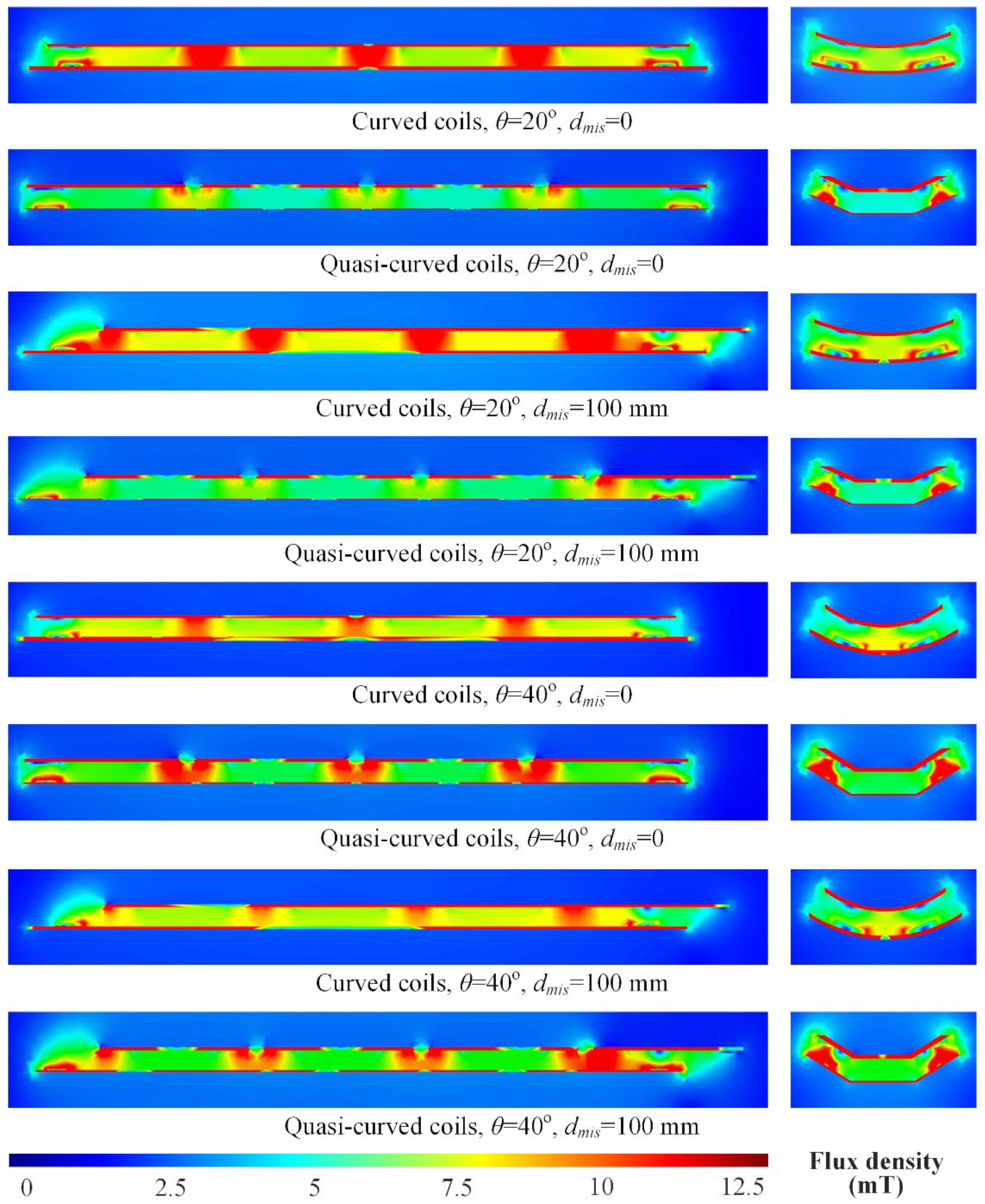Underwater Wireless Charging System of Unmanned Surface Vehicles with High Power, Large Misalignment Tolerance and Light Weight: Analysis, Design and Optimization
Abstract
:1. Introduction
2. System Configuration

3. Design of Coupling Coils for Large Misalignment Tolerance
3.1. Technical Challenges
- The medium of power transmission is changed from air to water. Accordingly, the physical properties, such as permeability and conductivity, also change, which may very likely weaken the coupling between Tx and Rx coils. Moreover, this problem becomes especially deteriorated in seawater, yet out of the scope of this paper since USV usually works in a freshwater lake.
- The components of UWCSs may not be sufficiently high-pressure-tolerant, including both the electronics and structural parts. For example, under a 4-km underwater condition, the pressure reaches 40 Mpa, and the permeability of magnetic core is reduced by more than 40%, which therefore jeopardizes the efficiency of UWCSs significantly [30]. Obviously, this problem can also be reasonably neglected for USV with its depth of immersion of less than one meter.
- The spatial relationship between Tx and Rx coils becomes complicated. In addition to horizontal misalignment, angular misalignment and the variation of Tx-Rx distance also exist in practice. What is worse, these misalignments are not stationary due to the water flow, which makes the stable output power even more difficult. Fortunately, in this paper, the type of misalignments is limited to a single direction, and the USV stability can be guaranteed owing to the Rx limiter.
- 4.
- Commonly used flat coils can hardly adapt to the curved shape of USV properly. For one thing, the magnetic coupling for power transmission is weakened inevitably due to the increased distance between Tx and Rx coils compared with double-sided curved coils. For another, flat coils require larger assembly space than curved coils, which is undesirable considering the compact structure of USV.
- 5.
- Equipping the original USV with a charging device will definitely expand its payload, which therefore influences its endurance and speed adversely. In this regard, the lightweight design of UWCS becomes an engineering challenge.
- 6.
- The output characteristics of UWCSs with small transmission distance remain unclear, especially in misaligned conditions. As explained in Section 2, the Tx and Rx coils are distanced at merely 20 mm, the thickness of epoxy resin layer on both sides together. Tight coupling is conducive to high output power yet misalignment-sensitive. In addition, resultant frequency splitting might cause the degradation of efficiency and power capacity and even unstable operation of UWCSs.
3.2. Comparison of Two Multi-Rx Coil Structures
4. Optimization of Coupling Coils Considering USV Endurance
4.1. Optimization Process
4.2. Curved Coils for USV-Shaped Adaption
4.3. Bar-Shaped Core for Lightweight Rx Assembly
5. Conclusions
Author Contributions
Funding
Conflicts of Interest
References
- Makar, A. Determination of the Minimum Safe Distance between a USV and a Hydro-Engineering Structure in a Restricted Water Region Sounding. Energies 2022, 15, 2441. [Google Scholar] [CrossRef]
- Specht, M.; Stateczny, A.; Specht, C.; Widźgowski, S.; Lewicka, O.; Wiśniewska, M. Concept of an Innovative Autonomous Unmanned System for Bathymetric Monitoring of Shallow Waterbodies (INNOBAT System). Energies 2021, 14, 5370. [Google Scholar] [CrossRef]
- Marchel, Ł.; Specht, C.; Specht, M. Assessment of the Steering Precision of a Hydrographic USV along Sounding Profiles Using a High-Precision GNSS RTK Receiver Supported Autopilot. Energies 2020, 13, 5637. [Google Scholar] [CrossRef]
- Painter, H.; Flynn, J. Current and Future Wet-Mate Connector Technology Developments for Scientific Seabed Observatory Applications. In Oceans 2006; IEEE: Piscataway, NJ, USA, 2006; pp. 1–6. [Google Scholar]
- Autonomous Survey Boat. 2019. Available online: https://www.oceanalpha.com/product-item/sl20 (accessed on 22 November 2022).
- Liu, C.; Hu, A.P.; Nair, N.K.C. Modelling and Analysis of a Capacitively Coupled Contactless Power Transfer System. IET Power Electron. 2011, 4, 808–815. [Google Scholar] [CrossRef]
- Urano, M.; Takahashi, A. Study on Underwater Wireless Power Transfer via Electric Coupling. In Proceedings of the 2016 IEEE International Meeting for Future of Electron Devices, Kansai (IMFEDK), Kyoto, Japan, 23–24 June 2016. [Google Scholar]
- Tamura, M.; Naka, Y.; Murai, K.; Nakata, T. Design of a Capacitive Wireless Power Transfer System for Operation in Fresh Water. IEEE Trans. Microw. Theory Tech. 2018, 66, 5873–5884. [Google Scholar] [CrossRef]
- Niu, S.; Xu, H.; Sun, Z.; Shao, Z.Y.; Jian, L. The state-of-the-arts of Wireless Electric Vehicle Charging via Magnetic Resonance: Principles, Standards and Core Technologies. Renew. Sustain. Energy Rev. 2019, 114, 109302. [Google Scholar] [CrossRef]
- Heeres, B.J.; Novotny, D.W.; Divan, D.M.; Lorenz, R.D. Contactless Underwater Power Delivery. In Proceedings of the 1994 Power Electronics Specialist Conference-PESC’94, Taipei, Taiwan, 20–25 June 1994. [Google Scholar]
- Granger, R.P.; Baer, C.M.; Gabriel, N.H.; Labosky, J.J.; Galford, T.C. Non-contact Wet Mateable Connectors for Power and Data Transmission. In 2013 OCEANS-San Diego; IEEE: Piscataway, NJ, USA, 2013. [Google Scholar]
- Zhang, K.; Zhang, X.; Zhu, Z.; Yan, Z.; Song, B.; Mi, C.C. A New Coil Structure to Reduce Eddy Current Loss of WPT Systems for Underwater Vehicles. IEEE Trans. Veh. Technol. 2019, 68, 245–253. [Google Scholar] [CrossRef]
- Yan, Z.; Zhang, Y.; Zhang, K.; Song, B.; Mi, C. Underwater Wireless Power Transfer System with a Curly Coil Structure for AUVs. IET Power Electron. 2019, 12, 2559–2565. [Google Scholar] [CrossRef] [Green Version]
- Cai, C.; Zhang, Y.; Wu, S.; Liu, J.; Zhang, Z.; Jiang, L. A Circumferential Coupled Dipole-Coil Magnetic Coupler for Autonomous Underwater Vehicles Wireless Charging Applications. IEEE Access 2020, 8, 65432–65442. [Google Scholar] [CrossRef]
- Zeng, Y.; Rong, C.; Lu, C.; Tao, X.; Liu, X.; Liu, R.; Liu, M. Misalignment Insensitive Wireless Power Transfer System Using a Hybrid Transmitter for Autonomous Underwater Vehicles. IEEE Trans. Ind. Appl. 2022, 58, 1298–1306. [Google Scholar] [CrossRef]
- Liu, Z.; Chen, Z.; Li, J. A Magnetic Tank System for Wireless Power Transfer. IEEE Microw. Wirel. Compon. Lett. 2017, 27, 443–445. [Google Scholar] [CrossRef]
- Kan, T.; Zhang, Y.; Yan, Z.; Mercier, P.P.; Mi, C.C. A Rotation-Resilient Wireless Charging System for Lightweight Autonomous Underwater Vehicles. IEEE Trans. Veh. Technol. 2018, 67, 6935–6942. [Google Scholar] [CrossRef]
- Mese, H.; Anilcan Budak, M. Efficiency Investigation of a 400W Resonant Inductive Wireless Power Transfer System for Underwater Unmanned Vehicles. In Proceedings of the 2020 IEEE Wireless Power Transfer Conference (WPTC), Seoul, Republic of Korea, 15–19 November 2020. [Google Scholar]
- Zhang, K.; Ma, Y.; Yan, Z.; Di, Z.; Song, B.; Hu, A.P. Eddy Current Loss and Detuning Effect of Seawater on Wireless Power Transfer. IEEE J. Emerg. Sel. Top. Power Electron. 2020, 8, 909–917. [Google Scholar] [CrossRef]
- Zhou, J.; Yao, P.; Chen, Y.; Guo, K.; Hu, S.; Sun, H. Design Considerations for a Self-Latching Coupling Structure of Inductive Power Transfer for Autonomous Underwater Vehicle. IEEE Trans. Ind. Appl. 2021, 57, 580–587. [Google Scholar] [CrossRef]
- Yan, Z.; Zhang, Y.; Kan, T.; Lu, F.; Zhang, K.; Song, B.; Mi, C.C. Frequency Optimization of a Loosely Coupled Underwater Wireless Power Transfer System Considering Eddy Current Loss. IEEE Trans. Ind. Electron. 2019, 66, 3468–3476. [Google Scholar] [CrossRef]
- Teeneti, C.R.; Truscott, T.T.; Beal, D.N.; Pantic, Z. Review of Wireless Charging Systems for Autonomous Underwater Vehicles. IEEE J. Ocean. Eng. 2021, 46, 68–87. [Google Scholar] [CrossRef]
- Niu, S.; Yu, H.; Niu, S.; Jian, L. Power Loss Analysis and Thermal Assessment on Wireless Electric Vehicle Charging Technology: The Over-temperature Risk of Ground Assembly Needs Attention. Appl. Energy 2020, 275, 115344. [Google Scholar] [CrossRef]
- Bi, Z.; Kan, T.; Mi, C.C.; Zhang, Y.; Zhao, Z.; Keoleian, G.A. A Review of Wireless Power Transfer for Electric Vehicles: Prospects to Enhance Sustainable Mobility. Appl. Energy 2016, 179, 413–425. [Google Scholar] [CrossRef] [Green Version]
- Jiang, C.; Chau, K.T.; Liu, W.; Liu, C.; Han, W.; Lam, W.H. An LCC-Compensated Multiple-Frequency Wireless Motor System. IEEE Trans. Ind. Inform. 2019, 15, 6023–6034. [Google Scholar] [CrossRef]
- Yoo, J.-S.; Gil, Y.-M.; Ahn, T.-Y. Steady-State Analysis and Optimal Design of an LLC Resonant Converter Considering Internal Loss Resistance. Energies 2022, 15, 8144. [Google Scholar] [CrossRef]
- Shafaei, R.; Perez, M.C.G.; Ordonez, M. Equivalence Relations of Resonant Tanks: A New Perspective for Selection and Design of Resonant Converters. IEEE Trans. Power Electron. 2020, 35, 9632–9649. [Google Scholar] [CrossRef]
- Yao, Y.; Wang, Y. A Novel Unsymmetrical Coupling Structure Based on Concentrated Magnetic Flux for High-Misalignment IPT Applications. IEEE Trans. Power Electron. 2018, 34, 3110–3123. [Google Scholar] [CrossRef]
- Xiang, L.; Sun, Y.; Tang, C.S.; Dai, X. Design of crossed DD coil for dynamic wireless charging of electric vehicles. In Proceedings of the 2017 IEEE PELS Workshop on Emerging Technologies: Wireless Power Transfer (WoW), Chongqing, China, 20–22 May 2017. [Google Scholar]
- Li, Z.; Li, D.; Lin, L.; Chen, Y. Design Considerations for Electromagnetic Couplers in Contactless Power Transmission Systems for Deep-sea Applications. J. Zhejiang Univ. Sci. C 2010, 11, 824–834. [Google Scholar] [CrossRef]
- Chen, H.; Niu, S.; Zhao, Z.; Jian, L. Wireless Power Transfer in Over-Coupled Region: Analysis on Frequency Splitting and Multi-Mode Frequency Selection Methods. In Proceedings of the 2021 IEEE 5th Conference on Energy Internet and Energy System Integration (EI2), Taiyuan, China, 22–24 October 2021. [Google Scholar]
- Wang, C.-N.; Yang, F.-C.; Nguyen, V.T.T.; Vo, N.T.M. CFD Analysis and Optimum Design for a Centrifugal Pump Using an Effectively Artificial Intelligent Algorithm. Micromachines 2022, 13, 1208. [Google Scholar] [CrossRef] [PubMed]
- Chen, Z.; Nguyen, V.T.T.; Tran, N.T. Optimum Design of the Volute Tongue Shape of a Low Specific Speed Centrifugal Pump. J. Electr. Electron. Syst. 2017, 6, 1–5. [Google Scholar] [CrossRef]
- Nguyen, T.; Vo, T. Centrifugal Pump Design: An Optimization. Eurasia Proc. Sci. Technol. Eng. Math. 2022, 17, 136–151. [Google Scholar] [CrossRef]
- Cheng, Y.; Shu, Y. A New Analytical Calculation of the Mutual Inductance of the Coaxial Spiral Rectangular Coils. IEEE Trans. Magn. 2014, 50, 1–6. [Google Scholar] [CrossRef]













| Parameter | Value 1 | Parameter | Value 1 | Parameter | Value 1 |
|---|---|---|---|---|---|
| lUSV | 1000 | dRx12 (nRx = 1) | 0 | lRx3 (nRx = 1) | 960 |
| wRx | 180 | dRx1 (nRx = 2) | 40 | lRx (nRx = 2) | 480 |
| dRx2 | 200 | dRx1 (nRx = 3) | 20 | lRx (nRx = 3) | 320 |
| dTR | 20 | dRx1 (nRx = 4) | 13.33 | lRx (nRx = 4) | 240 |
| dmis | 0–100 | dRx1 (nRx = 5) | 10 | lRx (nRx = 5) | 192 |
| θ (deg.) | MTR (μH) | θ (deg.) | MTR (μH) |
|---|---|---|---|
| 0 | 65.76 | 20 | 60.14 |
| 4 | 64.95 | 24 | 58.38 |
| 8 | 63.91 | 28 | 56.46 |
| 12 | 62.92 | 32 | 54.71 |
| 16 | 61.57 | 36 | 51.53 |
Publisher’s Note: MDPI stays neutral with regard to jurisdictional claims in published maps and institutional affiliations. |
© 2022 by the authors. Licensee MDPI, Basel, Switzerland. This article is an open access article distributed under the terms and conditions of the Creative Commons Attribution (CC BY) license (https://creativecommons.org/licenses/by/4.0/).
Share and Cite
Niu, S.; Zhao, Q.; Chen, H.; Yu, H.; Niu, S.; Jian, L. Underwater Wireless Charging System of Unmanned Surface Vehicles with High Power, Large Misalignment Tolerance and Light Weight: Analysis, Design and Optimization. Energies 2022, 15, 9529. https://doi.org/10.3390/en15249529
Niu S, Zhao Q, Chen H, Yu H, Niu S, Jian L. Underwater Wireless Charging System of Unmanned Surface Vehicles with High Power, Large Misalignment Tolerance and Light Weight: Analysis, Design and Optimization. Energies. 2022; 15(24):9529. https://doi.org/10.3390/en15249529
Chicago/Turabian StyleNiu, Songyan, Qingyu Zhao, Haibiao Chen, Hang Yu, Shuangxia Niu, and Linni Jian. 2022. "Underwater Wireless Charging System of Unmanned Surface Vehicles with High Power, Large Misalignment Tolerance and Light Weight: Analysis, Design and Optimization" Energies 15, no. 24: 9529. https://doi.org/10.3390/en15249529






